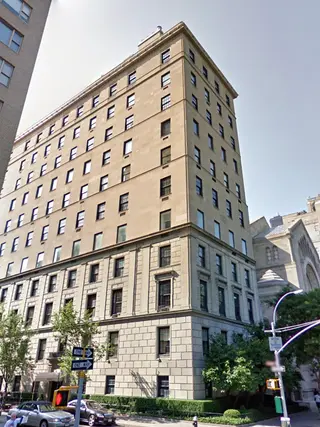 Carter Horsley
Carter HorsleyDec 23, 2011
Carter's Review
This handsome, 11-story, limestone-clad, cooperative apartment building at 4 East 66th Street on the southeast corner at Fifth Avenue is relatively plain for such a prestigious location, but its glories are internal and very substantial.
The building, which is just to the north of Temple Emanu-El, has only 18 apartments. Originally each floor had only one 18-room apartment, but a few were subdivided following its completion in 1920.
The building, which is also known as 845 Fifth Avenue, was designed by J. E. R. Carpenter, one of the city's most skilled residential architects, for William Henry Barnum. Cross & Cross were associated architects.
The building was converted to a co-operative in 1949.
Bottom Line
Most of the very spacious and grand apartments have five fireplaces and originally had seven servant’s rooms as well as Central Park views.
Description
The bottom four floors are clad in rusticated limestone and there are stringcourses above the second and fourth floors and there is a balustraded bandcourse above the tenth floor. The building has small cornice and a side-street entrance beneath a modest cast-iron balcony.
The building has large lintels above the second floor windows on the avenue and the end windows on the side street on the same floor.
The building has a canopied entrance and sidewalk landscaping.
Many of the apartments have some windows that overlook Temple Emanu-El on the adjacent avenue lot, which was formerly occupied by the twin houses of Mrs. William Astor and her son, John Jacob Astor.
Amenities
The building has a doorman, a concierge and sidewalk landscaping, but no sundeck, no health club, no balconies and no garage. The building is pet friendly. There is considerable traffic in the area as 66th Street at this location is a cross-town bus route.
Apartments
The apartments have very high ceilings of 11 to 13 feet and two huge, equally sized, 34-foot-long entertaining rooms that take up the entire Fifth Avenue frontage overlooking Central Park.
The apartments are entered from the 17-foot-long reception room that open onto a 33-foot-long gallery that lead to the 30-foot-long dining room and five bedrooms.
The library, drawing room, dining room and two of the bedrooms have fireplaces. The kitchen is 21-feet long and there is a 15-foot-long pantry.
There are seven servants’ rooms and a 12-foot-wide servants’ dining room.
History
"Carpenter was the man who set the twenties in motion. He was a Fifth Avenue architect, and he launched the decade with an apartment house that rose up above the Astor mansion at 66th Street like the ultimate challenge," wrote Elizabeth Hawes in her fine book, "New York, New York, How the Apartment House Transformed the Life of the City (1869-1930)," (An Owl Book, Henry Holt and Company, 1993). "For one last time, the neighbors, together with the Fifth Avenue Association, the City Club, and the Real Estate Board, responded with old-fashioned alarm, and for one last time, the city responded with restrictive legislation, which reduced the maximum building height on the park blocks between 60th and 96th Street from 150 feet to 75. It was a brief release from the tide of the times.
By 1923, Carpenter had brought a successful test case to judgment, which overcame the ruling and opened Fifth Avenue to apartment-house construction. The next year, the Astor place itself fell, and it was suddenly clear that the great family mansion - indeed the family house of any description - was going the way of the farms and shanties of earlier times." Hawes continued.
Carpenter designed about a dozen important Fifth Avenue apartment buildings such as 810 Fifth Avenue, 825 Fifth Avenue, 907 Fifth Avenue, 920 Fifth Avenue, 950 Fifth Avenue, 988 Fifth Avenue, 1030 Fifth Avenue, 1060 Fifth Avenue, 1120 Fifth Avenue, 1143 Fifth Avenue, 1148 Fifth Avenue, 1150 Fifth Avenue, 1165 Fifth Avenue and 1170 Fifth Avenue.
Bernard Baruch, the well-known financial advisor, lived on the second floor for many years.
Other residents have included Paul Allen, the co-founder of Microsoft, Veronica Hearst, Ace Greenberg, Ezra Silkha, and Sid Bass.

- Co-op built in 1920
- 1 apartment currently for sale ($30M)
- Located in Park/Fifth Ave. to 79th St.
- 18 total apartments 18 total apartments
- 10 recent sales ($1.5M to $101M)
- Doorman
 6sqft delivers the latest on real estate, architecture, and design, straight from New York City.
6sqft delivers the latest on real estate, architecture, and design, straight from New York City.
